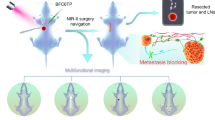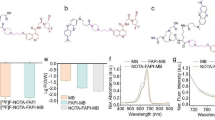Abstract
Aggressive surgical resection is the primary therapy for glioma. However, aggressive resection may compromise functional healthy brain tissue. Currently, there are no objective cues for surgeons to distinguish healthy tissue from tumor and determine tumor borders; surgeons skillfully rely on subjective means such as tactile feedback. This often results in incomplete resection and recurrence. The objective of the present study was to design, develop, and evaluate, in vitro and in vivo, a nanoencapsulated visible dye for intraoperative, visual delineation of tumor margins in an invasive tumor model. Liposomal nanocarriers containing Evans blue dye (nano-EB) were developed, characterized, and tested for safety in vitro and in vivo. 3RT1RT2A glioma cells were implanted into brains of Fischer 344 rats. Nano-EB or EB solution was injected via tail vein into tumor-bearing animals. To assess tumor staining, tissue samples were analyzed visibly and using fluorescence microscopy. Area, perimeter ratios, and Manders overlap coefficients were calculated to quantify extent of staining. Nano-EB clearly marked tumor margins in the invasive tumor model. Area ratio of nano-EB staining to tumor was 0.89 ± 0.05, perimeter ratio was 0.94 ± 0.04, Manders R was 0.51 ± 0.08, and M1 was 0.97 ± 0.06. Microscopic tumor border inspection under high magnification verified that nano-EB did not stain healthy tissue. Nano-EB clearly aids in distinguishing tumor tissue from healthy tissue in an invasive tumor model, while injection of unencapsulated EB results in false identification of healthy tissue as tumor due to diffusion of dye from the tumor into healthy tissue.






Similar content being viewed by others
References
Guthrie BL, Laws Jr ER. Supratentorial low-grade gliomas. Neurosurg Clin N Am. 1990;1:37–48.
Black P. Management of malignant glioma: role of surgery in relation to multimodality therapy. J Neurovirol. 1998;4:227–36.
Keles GE, Anderson B, Berger MS. The effect of extent of resection on time to tumor progression and survival in patients with glioblastoma multiforme of the cerebral hemisphere. Surg Neurol. 1999;52:371–9.
Yasargil MG, Kadri PA, Yasargil DC. Microsurgery for malignant gliomas. J Neurooncol. 2004;69:67–81.
Clarke J, Butowski N, Chang S. Recent advances in therapy for glioblastoma. Arch Neurol. 2010;67:279–83.
Sanai N, Berger MS. Glioma extent of resection and its impact on patient outcome. Neurosurgery. 2008;62:753–64. discussion 264–6.
Choucair AK, Levin VA, Gutin PH, Davis RL, Silver P, Edwards MS, et al. Development of multiple lesions during radiation therapy and chemotherapy in patients with gliomas. J Neurosurg. 1986;65:654–8.
Mornex F, Nayel H, Taillandier L. Radiation therapy for malignant astrocytomas in adults. Radiother Oncol. 1993;27:181–92.
Britz GW, Ghatan S, Spence AM, Berger MS. Intracarotid RMP-7 enhanced indocyanine green staining of tumors in a rat glioma model. J Neurooncol. 2002;56:227–32.
Kircher MF, Mahmood U, King RS, Weissleder R, Josephson L. A multimodal nanoparticle for preoperative magnetic resonance imaging and intraoperative optical brain tumor delineation. Cancer Res. 2003;63:8122–5.
Pham W, Medarova Z, Moore A. Synthesis and application of a water-soluble near-infrared dye for cancer detection using optical imaging. Bioconjug Chem. 2005;16:735–40.
Veiseh M, Gabikian P, Bahrami SB, Veiseh O, Zhang M, Hackman RC, et al. Tumor paint: a chlorotoxin:Cy5.5 bioconjugate for intraoperative visualization of cancer foci. Cancer Res. 2007;67:6882–8.
Nguyen QT, Olson ES, Aguilera TA, Jiang T, Scadeng M, Ellies LG, et al. Surgery with molecular fluorescence imaging using activatable cell-penetrating peptides decreases residual cancer and improves survival. Proc Natl Acad Sci U S A. 2010;107:4317–22.
Ozawa T, Britz GW, Kinder DH, Spence AM, VandenBerg S, Lamborn KR, et al. Bromophenol blue staining of tumors in a rat glioma model. Neurosurgery. 2005;57:1041–7.
Orringer DA, Chen T, Huang DL, Armstead WM, Hoff BA, Koo YE, et al. The brain tumor window model: a combined cranial window and implanted glioma model for evaluating intraoperative contrast agents. Neurosurgery. 2010;66:736–43.
Stojiljkovic M, Piperski V, Dacevic M, Rakic L, Ruzdijic S, Kanazir S. Characterization of 9 L glioma model of the Wistar rat. J Neurooncol. 2003;63:1–7.
Karathanasis E, Chan L, Karumbaiah L, McNeeley K, D’Orsi CJ, Annapragada AV, et al. Tumor vascular permeability to a nanoprobe correlates to tumor-specific expression levels of angiogenic markers. PLoS One. 2009;4:e5843.
Popovic Z, Liu W, Chauhan VP, Lee J, Wong C, Greytak AB, et al. A nanoparticle size series for in vivo fluorescence imaging. Angew Chem Int Ed Engl. 2010;49:8649–52.
Siegal T, Horowitz A, Gabizon A. Doxorubicin encapsulated in sterically stabilized liposomes for the treatment of a brain tumor model: biodistribution and therapeutic efficacy. J Neurosurg. 1995;83:1029–37.
Safra T, Muggia F, Jeffers S, Tsao-Wei DD, Groshen S, Lyass O, et al. Pegylated liposomal doxorubicin (doxil): reduced clinical cardiotoxicity in patients reaching or exceeding cumulative doses of 500 mg/m2. Ann Oncol. 2000;11:1029–33.
O’Brien ME, Wigler N, Inbar M, Rosso R, Grischke E, Santoro A, et al. Reduced cardiotoxicity and comparable efficacy in a phase III trial of pegylated liposomal doxorubicin HCl (CAELYX/Doxil) versus conventional doxorubicin for first-line treatment of metastatic breast cancer. Ann Oncol. 2004;15:440–9.
McNeeley K, Annapragada A, Bellamkonda R. Decreased circulation time offsets increased efficacy of PEGylated nanocarriers targeting folate receptors of glioma. Nanotechnology. 2007;18:385101–11.
International Telecommunications Union R. Rec. BT. Encoding parameters of digital television for studios. 1994; 601–4.
Folch J, Lees M, Stanley GHS. A simple method for the isolation and purification of total lipids from animal tissues. J Biol Chem. 1957;226:497–509.
Gaber MH, Wu NZ, Hong K, Huang SK, Dewhirst MW, Papahadjopoulos D. Thermosensitive liposomes: extravasation and release of contents in tumor microvascular networks. Int J Radiat Oncol Biol Phys. 1996;36:1177–87.
Karumbaiah L, Anand S, Thazhath R, Zhong Y, McKeon RJ, Bellamkonda RV. Targeted downregulation of N-acetylgalactosamine 4-sulfate 6-O-sulfotransferase significantly mitigates chondroitin sulfate proteoglycan-mediated inhibition. Glia. 2011;59:981–96.
Fillmore HL, Shurm J, Furqueron P, Prabhu SS, Gillies GT, Broaddus WC. An in vivo rat model for visualizing glioma tumor cell invasion using stable persistent expression of the green fluorescent protein. Cancer Lett. 1999;141:9–19.
Manders E, Verbeek F, Aten I. Measurement of co-localization of objects in dual-colour confocal images. J Microsc. 1993;169:375–82.
Hueper WC, Ichniowski C. Toxicopathologic studies on the dye T-1824. AMA Arch Surg. 1944;48:17.
Roberts LN. Evans blue toxicity. Can Med Assoc J. 1954;71:489–91.
Zinchuk V, Zinchuk O. Quantitative colocalization analysis of confocal fluorescence microscopy images. Curr Protoc Cell Biol. 2008; Chapter 4: Unit 4.19.
Raore B, Schniederjan M, Prabhu R, Brat DJ, Shu HK, Olson JJ. Metastasis Infiltration: an investigation of the postoperative brain–tumor interface. Int J Radiat Oncol Biol Phys. 2010; 1–6.
Sadzuka Y, Hirama R, Sonobe T. Effects of intraperitoneal administration of liposomes and methods of preparing liposomes for local therapy. Toxicol Lett. 2002;126:83–90.
Pradhan P, Giri J, Rieken F, Koch C, Mykhaylyk O, Doblinger M, et al. Targeted temperature sensitive magnetic liposomes for thermo-chemotherapy. J Control Release. 2009;142:108–21.
Agarwal A, Mackey MA, El-Sayed MA, Bellamkonda RV. Remote triggered release of doxorubicin in tumors by synergistic application of thermosensitive liposomes and gold nanorods. ACS Nano. 2011;5:4919–26.
Lindner V, Heinle H. Binding properties of circulating Evans blue in rabbits as determined by disc electrophoresis. Atherosclerosis. 1982;43:417–22.
Funding
This work was funded by support from the Georgia Cancer Coalition and Ian’s Friends Foundation to RVB.
Conflict of interest
The authors have no financial interests relevant to the technologies or data published in this manuscript.
Author information
Authors and Affiliations
Corresponding author
Rights and permissions
About this article
Cite this article
Roller, B.T., Munson, J.M., Brahma, B. et al. Evans blue nanocarriers visually demarcate margins of invasive gliomas. Drug Deliv. and Transl. Res. 5, 116–124 (2015). https://doi.org/10.1007/s13346-013-0139-x
Published:
Issue Date:
DOI: https://doi.org/10.1007/s13346-013-0139-x




